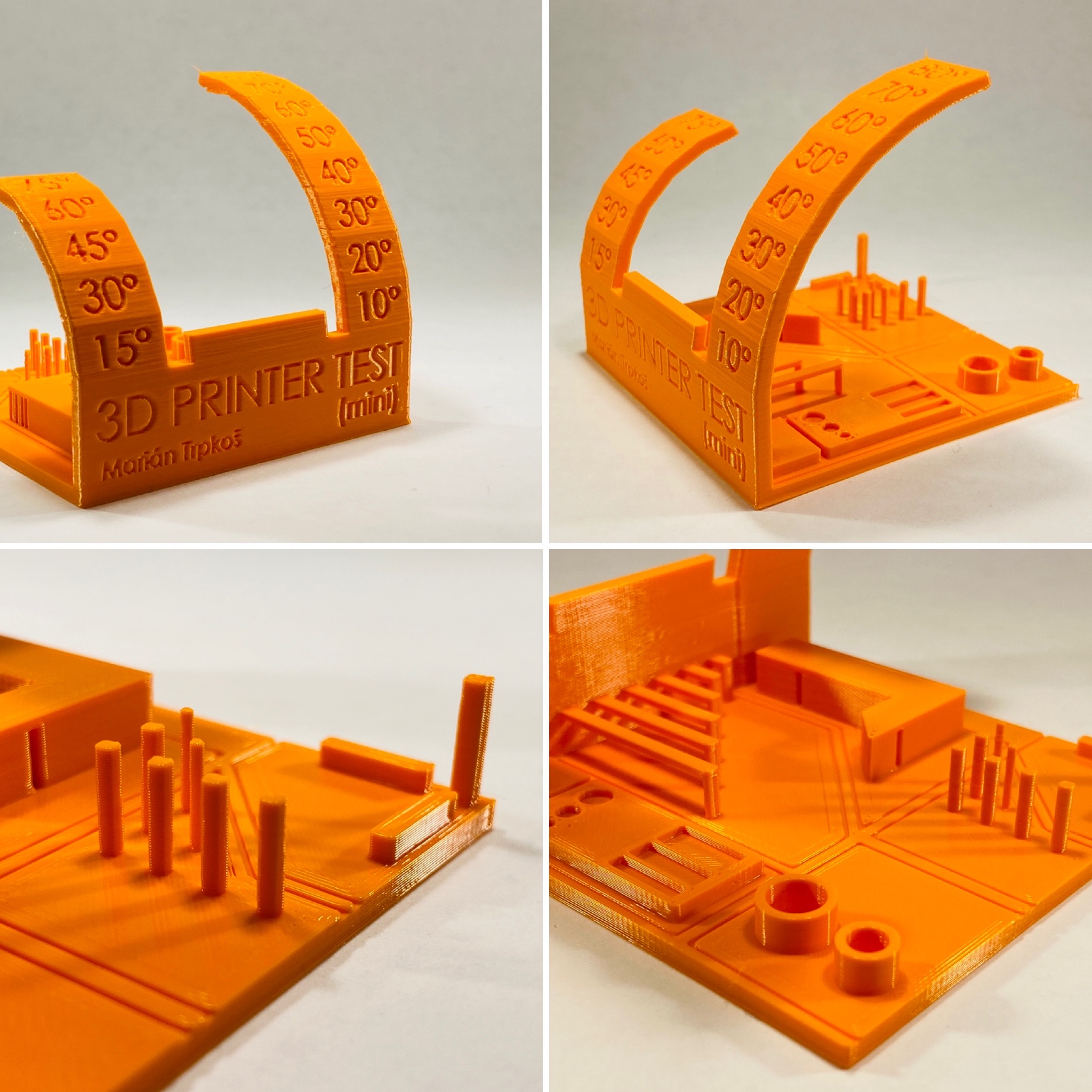
All in One 3D Test (Updated)
prusaprinters
<p><strong>Update 08.01.2022:</strong> Added some examples for test patterns included in this model.</p><p><strong>Update 12.01.2022:</strong> Updated presliced gcode to make sure heatbed is turned on.</p><p><strong>Update 18.01.2022:</strong> Uploaded additional stl with text on test patterns describing its purpose.</p><p> </p><p><strong>This Combination of Several Test Print Patterns Will Save a lot of Time Tuning your Printer.</strong></p><p>As for me I use this design on a regular basis to test for </p><ul><li>bridging</li><li>stringing</li><li>dimensional accuracy</li><li>overhang performance</li><li>cooling performance</li><li>general small feature, embossed letters and first layer performance</li></ul><p>and so on.</p><p>Especially on new machines or after I carried out modifications / using new filaments this model is very useful and efficient to reveal existing issues.</p><p>Therefore I modified the original design to better suit my needs and added a first-layer squashing test for example.</p><p><strong>Printing Recommendations:</strong> 0.2 mm layer hight, no supports needed, <br>100 % infill, 3 perimeters. </p><p><strong>Remark:</strong> The base model of this design was created by majda107 and licensed under CC Attribution.</p><p><strong>Tipp:</strong> Enable "Detect thin perimeters" in Prusa slicer for best results.<br>(“Print settings” -> "Layers and perimeters").</p><p><strong>Tipp: </strong>This is by purpose a quite comprehensive test.<br>For a very quick test / overview you might want to print a <a href="https://www.prusaprinters.org/prints/109020-xyz-calibration-cube-20mm-by-r3d-cali-cube">20mm XYZ-Cube</a> instead.</p><p>Hope you enjoy using this model as much as I do.</p><p>Happy printing!</p><p> </p><h3>Here're some examples for test-patterns included in this model and tipps for improving your printers performance by oberserving print results:<br> </h3><p><strong>1.) Overhang-Performance:</strong><br>Overhangs arise from the common layer-by-layer approach in 3D printing.<br>The higher this test model gets, the more steep the overhang-angle will get. <br> </p><figure class="image image-style-align-center image_resized" style="width:50%;"><img src="https://media.prusaprinters.org/media/prints/112816/rich_content/6cf09857-5c6a-497a-a3d2-2ec53805da14/img_1128.jpg#%7B%22uuid%22%3A%22c37e3fda-4e9d-4035-b698-9977fc06711c%22%2C%22w%22%3A4032%2C%22h%22%3A3024%7D"></figure><figure class="image image-style-align-center image_resized" style="width:50%;"><img src="https://media.prusaprinters.org/media/prints/112816/rich_content/17d641c6-756a-4d4d-8aad-5e38f280b32f/img_1130.jpg#%7B%22uuid%22%3A%22e49a7e70-4b58-49d6-b23c-0601a71dee53%22%2C%22w%22%3A4032%2C%22h%22%3A3024%7D"></figure><p>Overhang performance is for example influenced by:<br><br><strong>Cooling-Performance</strong> → Better cooling = better overhang performance<br><br><strong>Print speed</strong> → Slower speed = usually better overhang performance<br>(Especially for small features you might want to have a closer look at a variable called "minimum layer time")<br> <br><strong>Nozzle temperature</strong> → lower temperature = better overhang performance</p><p><br><strong>2.) Stringing-Test:</strong><br>Stringing (otherwise known as oozing, whiskers, or “hairy” prints) occurs when small strings of plastic are left behind on a 3D printed model.<br>With this test pattern of quite small towers side by side, your printer is forced to carry out a lot of filament retractions. Use this small features to check or tune these settings.<br> </p><figure class="image image-style-align-center image_resized" style="width:50%;"><img src="https://media.prusaprinters.org/media/prints/112816/rich_content/37234e6d-9129-4947-9919-cba7ed621ce5/img_1127.jpg#%7B%22uuid%22%3A%2221e84358-7c3e-4188-932b-4c0e0a3672f7%22%2C%22w%22%3A4032%2C%22h%22%3A3024%7D"></figure><p>Stringing performance is for example influenced by:</p><p><strong>Retraction settings</strong> → usually defined by retraction speed and distance you may vary these parameters. For Mk3S a viable starting point is 0.8mm @ 35mm/s retraction speed (PLA).</p><p><strong>Movement speed</strong> → when moving around the build plate without extruding, most extruders show oozing as a root cause for stinging. Try to increase movement speed while lowering print temperature to reduce stringing. But be aware of the fact that higher movement speeds may intruduce side effecty like ringing/ghosting.</p><p><br><strong>3.) Bridging-Performance:</strong><br><br>Basically when bridging, your printer is extruding right into the air without any support material below! Here's when cooling and filament-flow settings are most important.<br>Use this bridging test to challenge your printers mid-air-printing performance.</p><figure class="image image-style-align-center image_resized" style="width:50%;"><img src="https://media.prusaprinters.org/media/prints/112816/rich_content/90cd4b79-b48a-449f-ada3-3366d0b12fef/img_1126.jpg#%7B%22uuid%22%3A%22fa737f76-8a44-4b3c-bf26-14830a31cb95%22%2C%22w%22%3A4032%2C%22h%22%3A3024%7D"></figure><p>Bridging performance is for example influenced by:</p><p><strong>Cooling-Performance</strong> → better cooling = general better bridging performance</p><p><strong>Print speed</strong> → Slower speed = usually better bridging performance <br>(as it helps with quick cooling)<br><br><strong>Nozzle temperature</strong> → lower temperature = better bridging performance</p><p><strong>Filament-Flow</strong> → slightly decreasing filament flow while bridging will help with quicker material cooling and better bridging-performance for this reason. Clearly when your general flow is tuned correctly you only want a lower flow while bridging. Therefore most slicers and also prusa slicer feature a parameter called “bridge flow ratio”. Try to lower this variable slightly to improve bridging performance if you face any issues.<br> </p><p><strong>Uploaded additional STL-File with text:</strong></p><figure class="image image-style-align-center image_resized" style="width:50%;"><img src="https://media.prusaprinters.org/media/prints/112816/rich_content/da91086a-146d-488f-abe3-c231438b6ebe/18-01-_2022_19-22-44.jpg#%7B%22uuid%22%3A%223adf0888-b42a-47c4-b4f7-3ecd54f6b6ea%22%2C%22w%22%3A1213%2C%22h%22%3A1017%7D"></figure><p> </p><p><strong>Happy printing!</strong></p>
With this file you will be able to print All in One 3D Test (Updated) with your 3D printer. Click on the button and save the file on your computer to work, edit or customize your design. You can also find more 3D designs for printers on All in One 3D Test (Updated).
